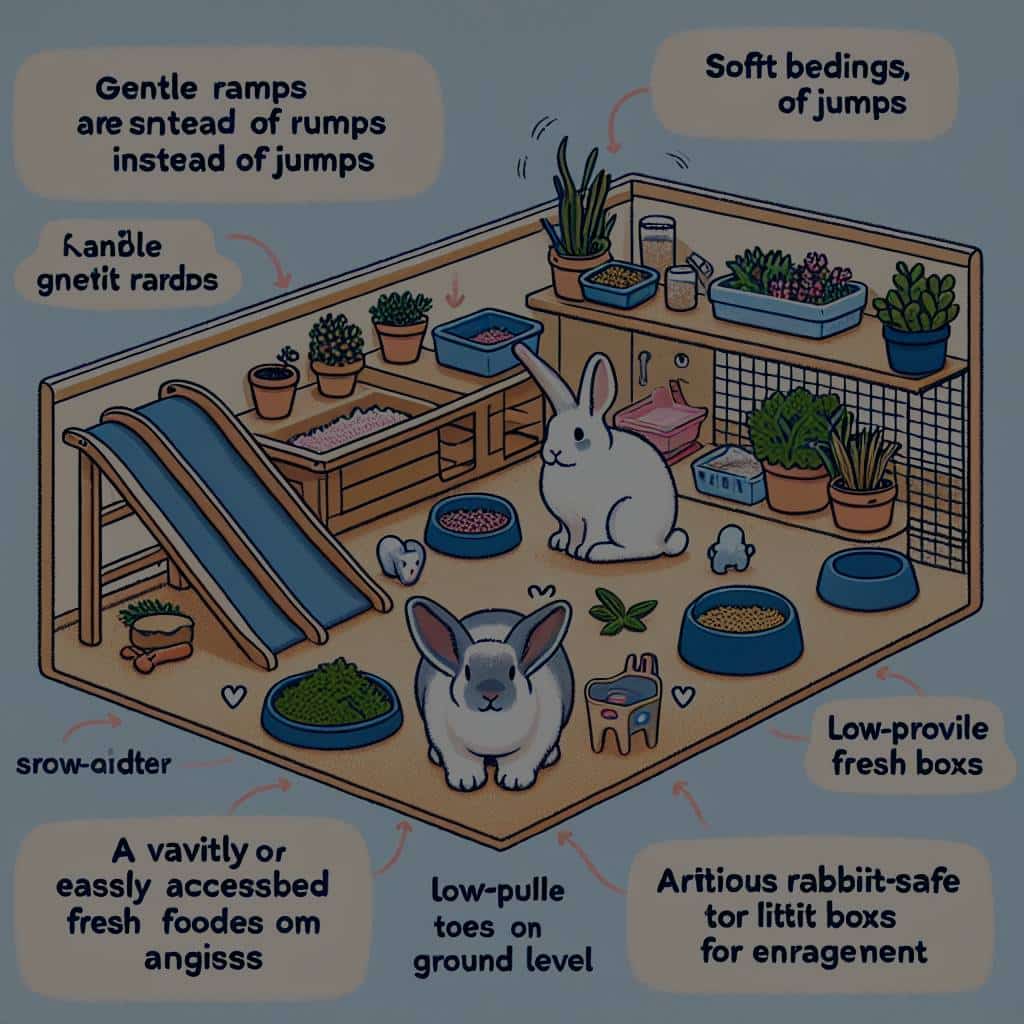In the world of pet ownership, rabbits often take a back seat to more conventional animals like dogs and cats. But these small, fluffy creatures are a joy to have around, providing endless hours of companionship and entertainment. As they get older, however, they can face health challenges—just like any other pet. One of the most common ailments in senior rabbits is arthritis, a degenerative joint condition that can affect their quality of life.
But have no fear, there are ways you can ensure your aging furry friend still enjoys a rich and fulfilling life. In this guide, we’ll focus on how to create an enriched environment for an arthritic senior rabbit, providing them with supportive care, suitable nutrition, and engaging activities. This will not only help in managing arthritis but also contribute significantly to their overall welfare.
Also read : What’s the Most Effective Way to Teach a Parrot to Use Puzzle Toys?
Understanding Arthritis in Senior Rabbits
Before diving into what it takes to create an enriched environment for your senior rabbit, it’s essential to understand what arthritis is and how it impacts their life.
Arthritis, a common issue in older rabbits, is a degenerative disease that affects the joints. This condition leads to discomfort and even pain for your pet. Signs of arthritis in rabbits include reduced mobility, reluctance to hop or climb, changes in behavior, and even weight loss.
Also to see : What Are the Optimal Tank Conditions for Breeding Neon Tetras?
While arthritis is a common age-related ailment in rabbits, it’s not a death sentence. With the right adjustments to their living conditions and daily routines, along with regular vet check-ups, you can help manage their discomfort and contribute to their overall health and well-being.
Providing Supportive Care
Supportive care is one of the most important aspects of managing arthritis in senior rabbits. This involves a variety of measures, including vet visits, medication, regular check-ups, and changes in their living conditions.
Regular vet visits are crucial in managing arthritis. Your vet can provide advice on medication to help manage pain and inflammation associated with arthritis. They will also monitor your rabbit’s health and make recommendations for any necessary changes in diet or living conditions.
Making changes in your rabbit’s living conditions can significantly help manage arthritis. Consider providing a softer bedding in their cage to cushion their joints. Ensure their food and water are easily accessible, so they don’t have to move around much. Lastly, keep the litter box clean and easy to enter and exit, as arthritis can make it difficult for them to keep up with their usual grooming habits.
Providing Suitable Nutrition
Just like with humans, good nutrition plays a significant role in managing arthritis in rabbits. You need to ensure that their diet is balanced and provides the necessary nutrients they need for their age and health condition.
Your vet can provide specific diet recommendations, but generally, senior rabbits require a diet high in fiber to aid digestion and maintain a healthy weight. Hay is an excellent source of fiber and should form the bulk of your rabbit’s diet.
Apart from hay, fresh vegetables are also an essential part of a rabbit’s diet. Choose leafy greens like lettuce, spinach, and parsley, and avoid vegetables high in sugar, like carrots. However, as arthritis might make it harder for your rabbit to chew, you might need to cut vegetables into smaller pieces or even lightly steam them.
Enrichment Activities and Exercises
Despite their arthritis, senior rabbits still require regular exercise to maintain their health. However, it’s important to adjust the type and level of exercise to suit their abilities and avoid causing further discomfort or injury.
Providing safe and gentle exercises can help keep their joints flexible and prevent muscle loss. Simple activities such as encouraging them to stand on their hind legs for a treat, or providing a step stool for them to climb can be beneficial.
In addition to physical exercise, mental stimulation is also crucial. Enrichment toys can provide this stimulation and keep your rabbit engaged. Choose toys that are easy for them to manipulate, such as balls with holes for them to push or soft chew toys.
Regular Interaction and Monitoring
Arthritis can affect not only a rabbit’s physical health but also their behavior and mood. Regular interaction and monitoring can help you detect changes in their behavior, which could indicate increased discomfort or pain.
Spend quality time with your rabbit, petting them, and providing gentle massages to help ease their discomfort. Engage in low-impact play that doesn’t strain their joints, such as gentle toss and fetch with soft toys.
Monitoring your rabbit’s behavior can help you notice any changes in their eating habits, activity levels, or general demeanour. This can provide insight into whether their condition is improving or worsening. Keep a close eye on their food and water consumption, as well as any changes in their litter box habits.
In summary, providing an enriched environment for an arthritic senior rabbit involves understanding their condition, providing supportive care and suitable nutrition, engaging them in gentle exercises and enrichment activities, and regular interaction and monitoring. With these measures, your furry friend can enjoy their senior years in comfort and happiness.
Dealing with ‘Sore Hocks’ in Arthritic Rabbits
An important aspect of rabbit welfare, particularly in senior rabbits dealing with arthritis, is the management of a condition known as ‘sore hocks’. This refers to painful, inflamed sores that develop on a rabbit’s hind feet, often as a result of pressure from hard flooring or excessive weight. Senior rabbits, especially arthritic ones, are particularly prone to developing sore hocks due to decreased mobility and changes in the way they sit or stand.
To prevent sore hocks in an arthritic rabbit, ensure that their living space has ample soft bedding. Consider using straw or hay, which can provide cushioning while also doubling as a snack. Avoid using hard or wire mesh flooring, as these can exacerbate sore hocks.
If your rabbit starts to develop sore hocks, immediate action should be taken to prevent worsening of the condition. Implement softer bedding if you haven’t already, and consult your vet for treatment options, which may include antibiotics or painkillers. Regularly clean the sores with a vet-approved antiseptic and ensure the litter boxes are kept clean to prevent infection.
Monitor your pet closely for signs of discomfort, such as reluctance to move, changes in eating habits, or noticeable pain when walking. These signs may indicate that the sore hocks are causing significant discomfort and require further veterinary attention.
Arthritis in Older Rabbits and Quality of Life
Arthritis in older rabbits can significantly affect their quality of life. However, with the right care and attention, your pet rabbit can still enjoy their golden years. Understanding the challenges they face, and providing an enriched environment that caters to their needs, can make all the difference.
Do remember that while arthritis in rabbits is common, it does not need to be a debilitating experience for your beloved pet. Provide them with supportive care, manage their diet well, engage them in gentle exercise, maintain regular interaction and ensure they are comfortable in their living conditions. These measures will help manage the symptoms of arthritis and ensure your rabbit’s welfare.
Keep a close eye on the litter tray for changes in your rabbit’s habits. This is often a good indicator of their overall health. Regular vet check-ups are crucial, as they can help monitor your rabbit’s condition and adjust treatment as needed. As a pet owner, your goal is to help your rabbit maintain a good quality of life despite their arthritis.
Conclusion
Arthritis in senior rabbits is a common condition that can affect their mobility and overall health. However, with the right approach, it’s still possible for your furry friend to lead a comfortable and fulfilled life. Creating an enriched environment involves not only making physical changes to their living conditions, but also ensuring they receive mental stimulation and emotional support.
By understanding their condition, providing supportive care, ensuring suitable nutrition, engaging them in safe and enjoyable exercises, and regularly monitoring their behavior, you can significantly improve their quality of life. Always remember, your rabbit’s happiness, comfort, and well-being should always be your primary concern. Indeed, with your love and care, your arthritic senior rabbit can enjoy their golden years in comfort and happiness.






